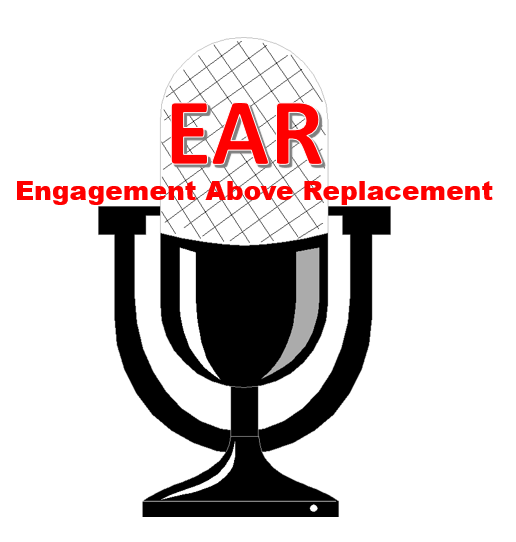
We may be starting out the pro and college football seasons, but for baseball fans, it’s looking like a September to remember. Several teams in both leagues are duking it out for a Wild Card playoff position, providing everyday drama to millions of baseball fanatics. As the pressure intensifies and the games become more critical, the idea of assessing how truly valuable players are to their teams becomes an ongoing debate among fans, pundits, and even managers and owners.
If you’re read “Moneyball,” you know that data analysis of player performance has become far more layered and granular, providing managers and owners with important insights. It started with statistician/fan Bill James and his “sabermetrics” (derived from Society for American Baseball Research) , and has become more nuanced over time.
A baseball player’s value used to be expressed with numbers equally simplistic to the ones we use in radio: home runs, runs batted in, and batting average for offensive players. And for pitchers, earned run average and the won-lost record. But observant fans know these stats frequently fall short, and are often dependent on more diverse events, ranging from luck, team performance, and other variables that simply don’t show up in the box scores.
And so my favorite baseball stat is – WAR – or Wins Above Replacement. WAR has become the all-purpose, single stat that attempts to answer the complicated question about value. A pretty good explanation of how it’s derived can be found here. WAR is a combination of many factors to evaluate the true value of a player to the team. Think about it this way: If a player was injured and had to be replaced, how much value would the team lose?
Of course, this is a parallel question to the one radio managers ask all the time about their shows, hosts, and personalities. What is the true value of talent to a station? If a personality’s contract was not renewed or a personality or team left town or moved to a station across the street, what impact would this have?
Like the traditional baseball stats, radio managers have the ratings to evaluate talent performance – cume, quarter-hour, and share. But in many cases, a personality’s value can transcend the ratings, and have an impact on other areas of the operation. As veteran programmers and managers know only too well, simple metrics can be deceiving. There are other factors – outside marketing, competitive forces, the overall health of the station, ratings vagaries, luck – that play a role in the ratings performance process.
As a result, many stations conduct perceptual research studies to provide more granular data about the impact of their personalities. This is where you can go beyond the ratings (or box scores) to better understand the appeal of radio shows, in addition to the individual personalities who are role players in an ensemble cast. Determining awareness and preference can also uncover an appealing personality who may be laboring in an unrated daypart, a weekend slot, or a time period that simply isn’t the beneficiary of a lot of persons using radio.

Not surprisingly, media researchers often attempt to develop questions that can better evaluate programs and personalities. Perceptual studies typically include personality awareness, followed by a 1-to-5 poor-excellent scale, providing a deeper indicator of appeal. But the true contributions (or lack thereof) go well beyond surface metrics like familiarity and an “excellent” versus a “good” rating. While ratings and recognition matter, it’s the intangibles that separate the good shows from the great ones.
Personalities whose value goes far beyond the ratings aren’t just working in markets like New York, L.A., or Chicago. While you often read about Elvis Duran, Kevin & Bean, and Eric & Kathy in the trades, dynamic, local, and powerful personalities are plying their trade in small and medium markets around North America as the graphic above shows.
While baseball’s WAR stat may be based on a combination of metrics, imagine rating a station’s personalities on the factors below using an excellent (4), good (3), fair (2), and poor (1) scoring system. Let’s call it EAR – or Engagement Above Replacement, and use the following eight variables as our differentiating factors:
- Coachability – How open to outside input of any kind are your personalities, hosts, and teams? Do they willingly and respectfully take advice from the programmer, consultant, or talent coach? Do they have a sense of curiosity about what’s working elsewhere in radio and in the entertainment business? Or are they resistant to criticism and new ideas?
- Sales Friendliness – These days, it’s not enough to get ratings. Personalities can make a bona fide contribution by helping the sales department, whether it’s in the form of agency appearances, impactful at client events, the ability to pull off a great live read, and even making an occasional sales call. The salespeople know the talent who truly are effective for them and the client.
- Community mindedness – A key for personalities up against everything from syndicated shows to satellite radio is the ability to truly root into the local area. Working community events, charities, and connecting with area leaders and celebrities is all part of building that all important local reputation and credibility. At its core, radio is local. Personalities who intrinsically get that are ahead of the game.
- Ambassadorial skills – The ability to connect with and serve the audience is a key variable, whether in person, on the phone, or in the social media environment.
 A willingness to embrace and acknowledge the audience is the key to earning a high score here.
A willingness to embrace and acknowledge the audience is the key to earning a high score here. - No drama – Personalities to a degree, and teams to a much greater degree can negatively differentiate themselves with an ongoing air of internal strife, infighting, bickering, and finger-pointing. Even when the ratings are great, a vibe of discontent, passive aggressiveness, and backbiting makes for a challenging atmosphere. And then there are the DJs and shows whose focus is clearly on the greater good, allowing them to minimize the angst.
- Current orientation – Some personalities and teams seem to gravitate to whatever the audience cares about. Focused content on buzzworthy, timely, and current events that matter to the target audience is a key to ongoing success. Some talent simply have an instinct for knowing where to go and what to talk about.
- A sense of reality – An understanding of the business of radio and how it works is an important asset for a personality. Understanding the economic realities, having an essential knowledge of ratings and what they mean, and developing a sense of what the station needs to do this quarter, next quarter, and next year can be a real plus.
- Fun factor – Some personalities are simply fun to be around. They lift up the entire operation and everyone on the staff wants to work with and support them. It’s a spirit of leadership the great shows have and they use it to everyone’s advantage.
So when you add up your EAR points, there’s a true difference between a personality with a 28 score versus one in the high teens. Yes, ratings and share are always going to be yardsticks of success. They determine many different outcomes from sales to bonuses. But like in baseball, a deeper look at the inside stats that measure a personality or team’s true value can help guide critical discussions that impact the entire organization.
There’s never been a time when radio’s personalities have meant so much to the long-term success of an operation. As baseball strives to better understand the contribution its players make to the team and the organization, radio needs to develop a better way of evaluating talent and what it means to stations and brands.
PAR Shows (clockwise from upper left): Carl Craft, WRAT/Monmouth, NJ, Chaz & AJ, WPLR/New Haven, Prospector, WEZX/Scranton, Rick Rumble, WNOR/Norfolk, Gerry Forbes, CJAY/Calgary, Radio From Hell, X96/Salt Lake City, Bob Lester, KWHL, Anchorage
- What Is It With Female Robot DJs? - April 30, 2025
- Why “Dance With Those Who Brung You” Should Be Radio’s Operating Philosophy In 2025 - April 29, 2025
- The Exponential Value of Nurturing Radio Superfans - April 28, 2025




Fred, I applaud your effort to quantify the MVP status of morning talent similarly to the bean ball insights in MLB.
Vin Scully is a good example of consistency in a daypart which was enabled by his relative immunity to radio consolidation over the years. The battle to stay in place for a decade+ so as to deliver consistent quality work in morning drive is one of the keys to unduplicatable victory in morning radio, especially in “noisy markets” with lots of distraction.
Easy to confuse and compare LOCAL personality appeal with National personality appeal in the LA market where both exist. Sam Reuben + Team on KTLA TV in mornings consistently top Matt Laurer + team on the Today show but Matt Laurer+Friends are far bigger national personalities obviously. Reality is there are far fewer LOCAL personalities in LA than National, so if scarcity is connected to value, that may be one relevant clue to the winning morning rating dynamics in the #1 radio market for folks doing a form of bean ball analysis.
Roy, thanks for the insightful comments. LA is a very different market for all the reasons you mention. That’s one of the reasons we drew attention to personalities in medium and small markets where it’s frankly easier to have that impact. Thanks for reading our blog.
Respect your work. Appreciate the information on your site!
Thanks.